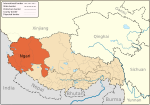Tsosib Sumkyil Township
Tsosib Sumkyil
ཚོ་སྲིབ་གསུམ་དཀྱིལ Churup Sumkhel, Chulusongjie | ||
|---|---|---|
County Zanda | | |
| Population | ||
| • Total |
| |
| • Tibetan language | ||
| Time zone | +8 | |

Tsosib Sumkyil (
Name
The township is named after two villages, both of which appear to have two native names.
Tsosib (
Sumkyil or Sumkhel (Tibetan: གསུམ་དཀྱིལ, Wylie: gsum dkyil, THL: sum kyil or Tibetan: གསུམ་འཁྱིལ, Wylie: gsum 'khyil, THL: sum khyil, also spelt Sumkyi, Sumgyi, Somgyi and Sonjie) is a farming village on a tributary of Pare Chu called Sumkyil Chu. (32°08′48″N 78°46′36″E / 32.1467°N 78.7766°E).
The Sumkyil Chu stream flows through a wide enough valley to support several farming villages along its course, including Manja (Chinese: 曼扎; pinyin: Màn zhā), Tuntun (Chinese: 顿堆; pinyin: Dùn duī) and Azire (Chinese: 阿孜热; pinyin: Ā zī rè). The reference to Sumkyil in the name of the township could also to the entire Sumkyil valley.
The historical name of the region was Tsotso,[3][4] or Tocho.[5]
Geography
The region of the Tsosib Sumkyil Township is entirely mountainous, with the western parts belonging to the
History
It is learnt that a good part of the township used to part of
The region appears to have become part of Tibet sometime before Ladakh came under the control of Dogras. In 1847, when the British boundary commissioners were sent to the region, they found the boundary of Spiti to lie between Kaurik and Tsurup.[6]
See also
- List of towns and villages in Tibet
Notes
- Office of the Geographer, 2012.[1]
References
- ^ Large Scale International Boundaries (LSIB), Europe and Asia, 2012, EarthWorks, Stanford University, retrieved 2 August 2022.
- ^ "Geographical names of Tibet AR (China): Ngari prefecture". KNAB Place Name Database. Institute of the Estonian Language. 2018-06-03.
- ^ Strachey, Physical Geography of Western Tibet (1854), p. 13:.
- ^ Gazetteer of Kashmir and Ladak, Calcutta: Superintendent of Government Printing, 1890, p. 654 – via archive.org
- ^ a b Report of the Officials (1962), p. 72.
- ^ Kaul, India China Boundary (2003), pp. 55–56: "Thus in Spiti, it is clear, that the boundary ran along the villages of Khyuri [Kaurik], Shaktolb and Chooret.".
Bibliography
- India, Ministry of External Affairs, ed. (1962), Report of the Officials of the Governments of India and the People's Republic of China on the Boundary Question, Government of India Press
- Kaul, Hriday Nath (2003), India China Boundary in Kashmir, Gyan Publishing House, ISBN 978-81-212-0826-0
- Strachey, Henry (1854), Physical Geography of Western Tibet, London: William Clows and Sons – via archive.org

